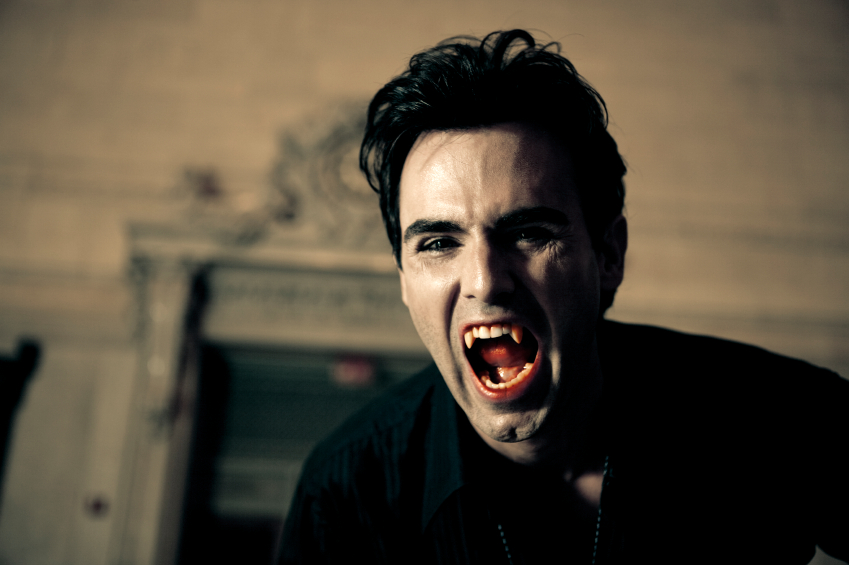Interview with a (Vampire) Scholar
From Bram Stoker to Blacula to Buffy, Baylor University scholar knows all things vampiric
Follow us on Twitter:@BaylorUMedia
Contact: Terry Goodrich,(254) 710-3321
WACO, Texas (Oct. 26, 2015) — Bloated and rosy-cheeked, sallow with long fingernails, fangs and foul breath, sexy and young, cuddly and goofy a la Grandpa Munster, melancholy and conflicted — vampires have been all of this and more since they emerged on the ghoulish scene centuries ago.
As a teen, Baylor University scholar J. Gordon Melton, Ph.D., was transfixed by science fiction — until he discovered vampires. Decades later, he wrote The Vampire Book: Encyclopedia of the Undead. He has a collection of thousands of vampire books, vampire comic books, vampire DVDs, vampire playscripts and poetry, and sundry other vampire-abilia, much of it locked away in a bank vault with security to rival that of Dracula's crypt.
Lest anyone think his encyclopedia was a one-hit wonder about the undead, be advised that Melton — who also researches religious traditions, new and alternative religions and parapsychology — recently published "The Vampire in Folklore, History, Literature, Film and Television: A Comprehensive Bibliography."
As Halloween approaches, the prolific author and Distinguished Professor in Baylor's Institute for Studies of Religion shares his infinite knowledge of the garlic-hating despisers of sunlight.
Q: I can see being fascinated by vampires, but how did you get absorbed enough to be a collector and vampirologist?
A: When I was young, I was buying vampire books, and they just never got thrown away. I got even more interested when Hammer Horror Films, a British company, decided to do a Dracula film shot in color instead of black and white. That made Christopher Lee into a superstar with "The Horror of Dracula" in 1958. Because of that, they made six sequels. In the last one, Christopher Lee had almost no lines because he was paid by the line and was so expensive. They couldn't afford him anymore.
Years later, in the 1990s, I was working with Gale Research, and they called me in to do my contract and asked if there was anything else I'd like to do. This was about the time when Francis Ford Coppola's "Dracula" with Gary Oldman came out, and academic studies of vampires were heating up. I gave them my list, and the last item was a vampire encyclopedia. They pounced on it. That's the only time I've seen one of my books in a bookstore window.
Q: What is some of the history/folklore behind vampires?.
A: One story in folk culture was that mothers who lost their babies during childbirth or soon after, and they preyed on the babies of others. Maybe that was inspired by crib death. The women were usually also considered witches. The first written account was in a Greek manuscript from North Africa, and you find those stories in Africa, Southeast Asia and the Caribbean. In Eastern Europe, you had written accounts of unusual births and deaths — something like a caul over a baby's face or a birthmark — and someone, almost invariably a man — dying away from the village or accidentally, or maybe off in a war and without a wake. In some places, where it was very cold and the ground was hard, someone might be buried quickly in a shallow grave or placed in an icehouse and re-buried later. In Western Europe, if they looked at the body and the flesh was still there, they'd think "That's a holy person." But in Eastern Europe, if you went back and the flesh was still there, that was considered an unholy person.
Q: Some people think that certain movie vampires are attractive — Tom Cruise, Brad Pitt. And then there's the Dracula movie in which Frank Langella is crawling down that wall toward the window . . .
A: That's part of the appeal. Up until the 1960s, much of what we repressed was our sexuality. Ninety percent of the letters Bela Lugosi got were from women. Same thing with Christopher Lee. Frank Langella is the full-blown romantic hero. Then came Gary Oldman, the seducer.
A side note is that in Eastern Europe, if your husband died, you were supposed to be in mourning for a year. So what happens if six months later you turn up pregnant? "Vampires" were used to cover up affairs. And the child, rather than being regarded as a bastard vampire and half vampire, was viewed as a vampire hunter. That gives you special status.
Q: Tell me about your collection of vampire things.
A: I began collecting unsystematically and for the fun of it. Now I have more than 800 copies of (Bram) Stoker's 1897 novel "Dracula." An interesting thing about it is that the original version was sent back to Stoker to be edited and cut down. The original title was "The Undead," but at the last moment, he changed the name. And in the original ending in the manuscript, Dracula's castle gets blown up.
I have some 6,000 or 7,000 other books, around 9,000 comic books, 1,000 non-English books, about 800 movie versions . . . I've found about 2,400 movies that have been made, some of which are very hard to get copies of and very expensive. I have a limit of what I'll pay for one — essentially $10 a copy.
I also have about two dozen cookbooks, some with recipes from Transylvania, and even a diet cookbook from New Orleans. I pretty much stick with the red drinks that use cranberry.
Q: What are some of the significant ways vampires have changed over time?
A: Up until the 1970s, they're all evil, and the only ending is to kill them. What happens in the '60s and '70s are two new things: We're introduced to the conflicted vampire, who retains enough of his humanity to have a conscience and frets over killing and drinking blood. He either tries to find a substitute for blood, or "takes out the garbage" by selecting people who should die. A variation on that is the "good-guy" vampire who likes the status, the long life, and has found a way to not kill. The other thing is that while there were female vampires before, the first "good-girl" vampire was Vampirella in 1969 in a comic book. She comes from a planet where blood flows like water, but it's drying up. She comes to Earth and gets hold of a scientist who makes artificial blood. Vampirella was modeled after a young Jane Fonda in the movie "Barbarella," and Vampirella grew more and more buxom over time.
In the 1970s, they began to develop vampires for kids, like the character in "Sesame Street." When the "Twilight Saga" came along, you had a vampire book on The New York Times bestseller list for the first time. Vampires even took a humorous twist, like in "Dracula: Dead and Loving It" and "Love at First Bite" . . .
Q: One of the things I've always found intriguing and confusing is the various "surefire" ways to kill a vampire for good: beheading, stake through the heart, put them in the sun . . .
A: In early European folklore, one way was to cut off the head, put it between the legs and stake the body. Originally they were turned over and staked through the back. But in 19th-century literature, you went through the rib cage to aim at the heart. A long time ago, some people believed that vampires should be buried upside down, so that if they started digging, they'd go down into the earth instead of out of it. But in a movie or on TV, what happens when police show up and the corpse has a stake in it? What happens when there's an autopsy and you find fangs? In "Buffy the Vampire Slayer," she dissolves them into dust. With dust, you don't have to deal with the police.
There are other rules about vampires that keep changing on TV and in movies as people come up with ingenious ways of killing the mix of myths. Some vampires are allowed to walk in the sun, have a reflection in the mirror . . . Before, you couldn't take a photo of a vampire because it didn't have a soul. In "Love at First Bite," Van Helsing comes in with a cross, and the vampire is of Jewish heritage. He says, "You'll have to use a Star of David." In the "Twilight" films, vampires can got out in the sun, but they sparkle. And "Buffy" was just phenomenal in the amount of changes. She brought the most comment from academics.
Q: What's going on with "vampires" in the real world?
A: In the last 25 years, there is a community of big vampire wannabes. They start adopting a vampire lifestyle — sleeping during the day and working at night, buying a hearse and making it the family car, buying coffins and sleeping in them, going to vampire nightclubs, wearing powder to turn their faces white . . . In the 1990s, there were some people who tried drinking blood, but the body just doesn't accept that as food and regurgitates it. A few would drink small amounts of it in orange juice, but that kind of petered out . . . Now there are what we call "psychic vampires." What they're really after is life energy, the transfer of energy, and they think they're capable of doing that. Then there's the "sapped energy joke" — people who just suck the life out of you.
Q: How do people react when they find out you research vampires?
A: There are a lot of very bad jokes and puns.
ABOUT BAYLOR UNIVERSITY
Baylor University is a private Christian University and a nationally ranked research institution, characterized as having "high research activity" by the Carnegie Foundation for the Advancement of Teaching. The University provides a vibrant campus community for approximately 16,000 students by blending interdisciplinary research with an international reputation for educational excellence and a faculty commitment to teaching and scholarship. Chartered in 1845 by the Republic of Texas through the efforts of Baptist pioneers, Baylor is the oldest continually operating University in Texas. Located in Waco, Baylor welcomes students from all 50 states and more than 80 countries to study a broad range of degrees among its 12 nationally recognized academic divisions. Baylor sponsors 19 varsity athletic teams and is a founding member of the Big 12 Conference.
ABOUT THE INSTITUTE FOR STUDIES OF RELIGION
Launched in August 2004, the Baylor Institute for Studies of Religion (ISR) exists to initiate, support and conduct research on religion, involving scholars and projects spanning the intellectual spectrum: history, psychology, sociology, economics, anthropology, political science, epidemiology, theology and religious studies. The institute's mandate extends to all religions, everywhere, and throughout history, and embraces the study of religious effects on prosocial behavior, family life, population health, economic development and social conflict. While always striving for appropriate scientific objectivity, ISR scholars treat religion with the respect that sacred matters require and deserve.

